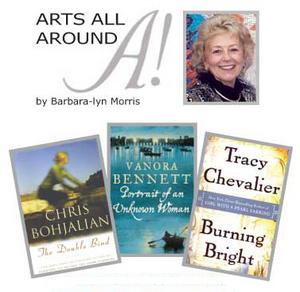

Recommended reading includes three suggestions from the art-fiction genre made popular the last few years.
My apres-ski and spring-break reading has again provided sources for this almost annual column of recommended summer art-related reading. I have three suggestions from the art-fiction genre made popular the last few years. I am happy to report the trend is growing in number of authors and depth of subject matter as well as breadth of the arts covered.
Tracy Chevalier, the author who is credited with starting the arts-related fiction craze with Girl With a Pearl Earring, has scored again with a work even more clever than her first four. In the aftermath of the American Revolution and the days of the French Revolution hovering in the background, Burning Bright (Dutton, 2007) is set in London between March 1792 and July 1793. The protagonists are Maggie, a poor girl too wise in the ways of the city, and Jem, a quiet country boy adjusting to the challenges of the city. These two and their friend Maisie come of age in a time of great uncertainty.
Woven through the story are the historical figures William Blake (1757-1827) and his wife. Blake - the radical thinker, printmaker, poet, and mystic - asks central questions about the conditions of innocence and experience both in his exchanges with neighborhood youngsters and in his twin poems, Songs of Innocence and Songs of Experience. The title Burning Bright comes from Song 42, "The Tyger," in which Blake asks a series of unanswered questions about how to reconcile good and evil in the world.
Vanora Bennett's first publication to explore the popular art-history device is Portrait of an Unknown Woman (William Morrow, 2007). The setting is also England, but two centuries earlier than Chevalier's setting. This time the contextual turmoil is the Protestant Reformation and Catholic King Henry VIII's untenable circumstances, that of wanting to divorce his wife and marry Ann Boleyn. The featured historical artist is German portrait painter Hans Holbein (1497-1543) and the other central historical characters are Sir Thomas More (1478-1535 ) and his family. The bookends of the novel are the circumstances of Holbein's painting two group portraits of the More family five years apart. The differences in the paintings unravel family secrets, supposedly buried deep in the hearts and consciences of various family members.
Bennett's work is more than clever; it's complex. She may give Chevalier significant competition in the craze for art-history quasi-mysteries. I highly recommend Bennett's first foray into the field of passion for politics, romance, religion, and art.
A birthday present, The Double Bind by Chris Bohjalian (Shaye Areheart, 2007) is the first book I have read by this popular mystery writer, known for using fiction to attack social issues, such as gun control, animal rights, and - this time - homelessness and mental illness. The giver explained the rationale for this particular choice for me by saying: "It's about two things you like - photography and literature." I admit to being a bit skeptical but once I began, I could not stop reading this work, which is illus-trated by real photographs left behind by a homeless person in Vermont.
The cast includes a recent college graduate who was the victim of a brutal attack while riding her bike, and most of the characters from F. Scott Fitzgerald's The Great Gatsby. The haunting thriller explores the sources of good and evil, in ways parallel to Burning Bright. My only caveat to readers is to read Fitzgerald's work first or refresh your knowledge of the classic fictional commentary on excesses of the Roaring Twenties.
Three gifts of poetry have been added to my collection and hold their special place by my bed ready to deliver a daily dose: Poem A Day, Vol 2, edited by Laurie Sheck (Steerforth Press, 2003), and Low Explosions: Writings on the Body, edited by Casie Fedukovich with Steve Spards (Knoxville Writers' Guild, 2006), and Poet Lore: A 2nd Century of New Writing (Writer's Center, Bethesda, MD, Spring/Summer 2007).
The first collection is one of three volumes offering 365 classic and modern poems. I never cease to be amazed at how often I find the daily offering just perfect for that day. Low Explosions is very special not only because the contributors reside mostly in Northeast Tennessee and Southwest Virginia and consequently have a reverence for this part of the country, but most particularly because each work, literary or visual, explores the "shrine both ancient and modern, the human body...."
I first turned to the contributions of two friends: Felicia Mitchell and Edison Jennings. Their poems, "Missing" and "Body Heat" respectively, have left haunting, intimate images I find myself recalling from time to time. I highly recommend this ambitious undertaking of the Knoxville Writers' Guild - in small doses and not necessarily on the beach.
You may ask about my beach or mountain summer reading list. I plan to pay homage to two recently deceased writers by reading or rereading some of the works of Kurt Vonnegut (1922-2007) and David Halberstam (1934-2007). Vonnegut's fiction and Halberstam's nonfiction offer critical social commentary and unusual insight into the making of America in the 20th century, from the Allied bombing of Dresden during World War II in Slaughterhouse-Five to Halberstam's overview of the Vietnam War in The Best and The Brightest. My husband recommends Halberstam's sports writings, such as Summer of '49 (Yankees vs. Red Sox) and The Teammates (60-year friendship of four Red Sox players).